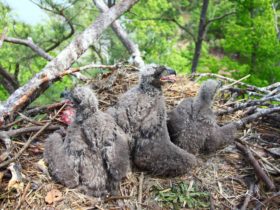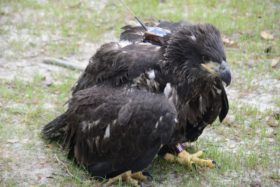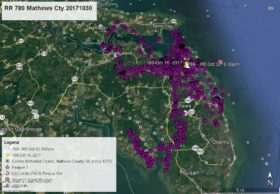Azalea's back at the landfill
Where are the Satellite Eagles?
October 4, 2009Azalea's back on the Potomac
October 9, 2009
Categories

Azalea has returned to the landfill in King and Queen County, VA. CCB has documented other transmittered eagles using this site to forage and roost. She’s likely learning from other eagles how to hunt the seagulls that live at the landfill. This will be an important skill as fish become less available in fall and winter and many eagles switch their diet to waterfowl and gulls.
Libby




11 Comments
Thanks for posting the update, Libby 🙂 I have a question. We know eagles scavenge and they can have problems with bacterial infections from food sources (dumps) If Azalea is feeding on gulls and other fowl that also scavenge is her chance being affected decreased?
Interesting question Ann. I’m not familiar with baterial diseases in birds acquired directly from landfills. I do know that in other states, eagles have died after scavenging euthanized animal carcasses. Ideally these carcasses are immediately buried to prevent scavenging but this doesn’t always occur.
Checking in from the airport in Paris, France. Libby will be posting the maps and fielding your questions for the next two weeks, as I float down the Danube River from Vienna to Bucharest. Hope to introduce a few folks from Eastern Europe to Azalea, CCB and NBG. Hope Azalea stays out of trouble while I am away.
Reese
I thought Ms. Azalea had an aversion to feathers. Is there something else at the dump she’ll be able to eat that’s safe? 🙂
Anything to help her overwinter this first year if she doesn’t get some kind of disease. Helen
I often wondered about wildlife eating at the dump
It would only make sense that its full of disease.
Hope Azalea stays safe and heathy as she goes
thru this first year of life,and may she have a long
life after that. Thanks for all the updates. Have a great time Reese
according to the map i got in email today she’s back at the river again
ray – Yes, it does appear that Azalea has returned again to the shores of the Potomac River.
Reese – from Bratislava, Slokavia
Reese – can we track you? Can we live vicariously through you? Thank you for keeping us up-to-date on your adventures too!
Reese – ENJOY – and make sure you rest up before your class on the 24th. You know we’re a tough group!!
i am so glad our girl is doing fine. i wish she would find a nice place to stay for the weather, coming back home would be nice.i don’t think mom and dad would mind to much.i think everyone else would like her here also,that would be so cool if she came home.god bless her and take care of her for her family in hampton roads.cann’t wait for another up-date.